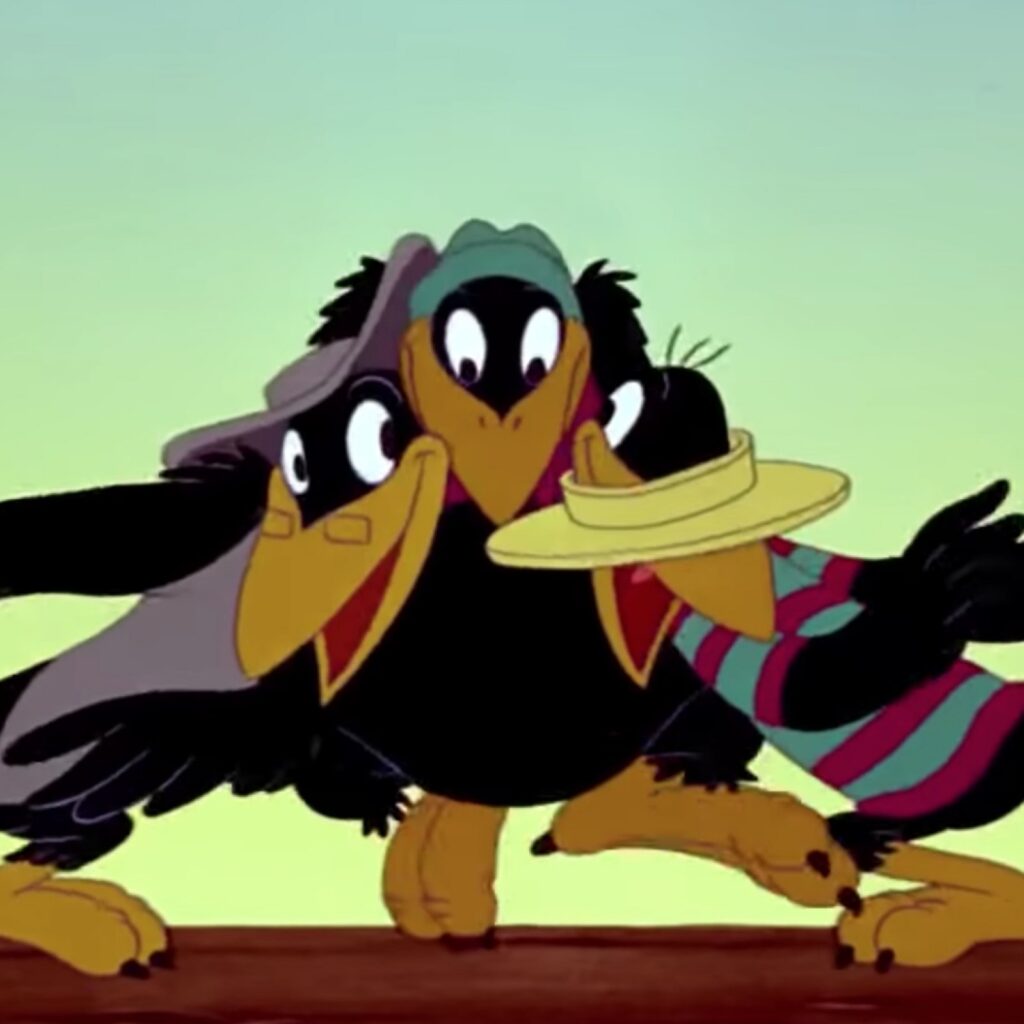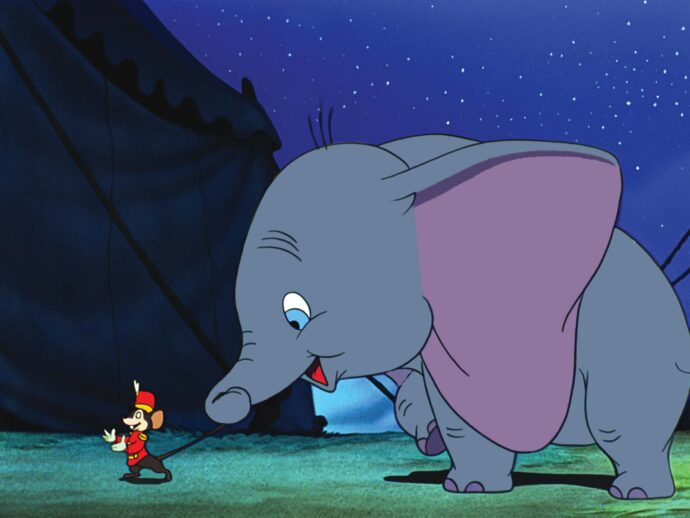Plus or Minus is a series detailing and analyzing every feature film now streaming on Disney+. It combines the unique history all these films share, their cultural impacts, and their qualities, or lack thereof. From timeless classics, to acquired hits, to DCOMs, no stone will be left unturned.
Plus or Minus returns after some live-action pieces with yet another animated classic, Dumbo. Jumbo Jr. is a baby elephant and son to Mrs. Jumbo, an elephant circus performer. However, upon his delivery, he is born with extremely large ears. This makes him a punching bag among the other circus members and patrons, giving him the nickname of Dumbo. And despite trying his best to fit in and follow his fellow elephantine troupe, he causes nothing but trouble for the Big Top.
But despite his large ears and pariah status among the circus animals, with the help of a mouse named Timothy, Dumbo looks to use his supposed freaky ears as a gift. And with those ears, he will take charge and give the world something they had never seen before. An elephant with the ability to fly.
Surprisingly Important
While Dumbo is credited for its importance in the Disney canon, many don’t recognize how important it truly was for the company. This animated adaptation of the children’s book written by Helen Aberson and Harold Pearl about a little baby elephant helped keep the studio alive at a time when it could have gone under. And all of it is because of how cheap the film is.
Despite the massive box office success of Snow White, Disney’s follow-ups saw far worse results. With World War II raging over Europe, theatrical markets were forced to close down. Gee, I can’t imagine how that feels. This caused huge money losses for both Pinocchio and Fantasia, which both cost a fortune to make. The studio was on the verge of bankruptcy and they needed money from a new feature.
While Dumbo was originally going to be a short, Walt felt there was just enough material for an hour-long feature film. And with it only being an hour long and little in terms of special effects, it was an easy film to make on the cheap. And thus, a company savior was born!
With only a $950,000 budget, chump change compared to Pinocchio or Fantasia, Dumbo both brought in solid revenue as well as rekindled interest in Disney’s animated features. Fair to say the filmmakers of Frozen or Zootopia have this cheap little piece to thank for giving them a job. And over the years, Dumbo has earned an iconic Disneyland ride, a Disney Channel television series and even a mediocre live-action remake.
The Simplicity Of It All
The best way to describe Dumbo is a feature-length Silly Symphony. For those unaware, Silly Symphonies were animated shorts created by The Walt Disney Company. They were episodic tales that told simple stories, often built around a musical score.
This isn’t a criticism. In fact, despite the lack of innovation or creative ambition, Dumbo still works thanks to one thing: its heart. While the animation is bouncy and many of the setpieces are entertaining, Dumbo’s story is a very sweet and earnest one.
While the character of Dumbo never says a word, the animators know how to bring in a curious and sweet edge that makes him understandable and relatable. And his innocent nature helps the film’s themes and ideas. For all intents and purposes, Dumbo’s story is one about prejudice and mistreatment. And while simple, it’s very effective.
The bullies Dumbo faces are cruel and vindictive, and the stuff the little baby elephant goes through is real heart-wrenching stuff. This lack of sugarcoating only makes the joyful and happy moments all the more cathartic and beautiful. While not ambitious from a storytelling perspective, its emotional core still rings true.

The Wild World of Dumbo
Despite not having as many special effects or groundbreaking animation, Dumbo is still lovely to look at. The colors are vibrant, the character animation is dynamic, and the character designs are appealing and full of energy. Perhaps the most intriguing aspect of the animation as a whole comes down to the surreal and bizarre world Walt’s team created here.
The world of the circus is an odd one. Crazy clowns dart across the screen, animals populate the scene, and many sequences are full of oddities. It’s such a strange, yet vibrant creation here that’s fun to watch. Dumbo is the perfect viewer, with his sweet innocence sharply clashing with the surrealism and mayhem on screen.
Perhaps the most famous sequence of the whole film, at least excluding the more racist moments of the film, is “Pink Elephants on Parade”. In a sequence featuring Dumbo accidentally getting drunk on champagne, a series of bubbles emerge. In a wild hallucination, said bubbles transform into giant pink elephants in the sky. They invade the screen, go on a parade, dance the night away, and end on one mind-bending trip of a climax.
It’s nonsensical but it’s a delight to see such gorgeous and strange imagery in an animated piece like this. It’s also simply pure joy to see the animators go wild and crazy with the idea.
The…Unfortunate Side Effects
Since Dumbo’s initial release, one of the biggest criticisms has been its racist undertones. And yeah…those aren’t pretty. Even before we get into the real controversial stuff, the circus set-up is all kinds of uncomfortable. The beginning of the film sees both the animals and a group of laborers. The laborers are Black. And they sing a song titled “Song of the Roustabouts.” There, the Black workers sing about how much they love to work. They love work so much they had no interest in learning how to read or write. There’s also this set of lyrics: “We don’t know when we get our pay. And when we do, we throw our pay away”.
It is beyond tough to listen to such lyrics. Cute baby Dumbo swinging his little hammer doesn’t hide the offensive undertones. But of course, that’s not the moment everybody talks about. Near the end of the movie, a group of crows enter the scene, all of which play into African-American stereotypes. Their clothing, dialect, and mannerisms all play into awkward, minstrel-esque tropes that are uncomfortable. The lead crow is named Jim for goodness sake! By the way, Jim’s actor also voiced Jiminy Cricket.

At the same time, this has also seen some defenses. The crows are heroes, the majority are voiced by Black actors, and serve as figures that are sympathetic to Dumbo’s plight. They’re in fact the only characters outside of Timothy that show any remorse towards the guy. Even Disney animator Floyd Norman argued in favor of the crows.
However, while Dumbo is definitely not the most egregious example of Disney racism, it’s still hard to watch at points. I will fully admit I was more positive over The Reluctant Dragon, which had its fair share of homosexual stereotypes, and also posited an oppressed character as a hero. Yet I feel Reluctant Dragon never went this far in the mockery of an oppressed community. Although I am aware plenty will disagree with me on this, and I don’t blame them.
The language and designs of the crows dip into minstrel territory one too many times, and it’s hard not to be annoyed by such awful depictions. At the very least, their presence, like with the Black workers, is only one scene, but it does make one wish the film could move on from these awkward and offensive moments.
Plus or Minus?
With all that said, is Dumbo a Plus or Minus? One can’t deny its legacy, both good and bad, but is there still something to enjoy nearly 80 years later? Quite honestly, there’s a lot to like. The animation is exciting, the designs are silly and fun, and there’s a really strong emotional hook and likable character to anchor it all. It’s no wonder it was such a hit in 1941 and has lived on as a staple in the Disney canon.
For its imagination and its heart, between Plus and Minus, Dumbo is a very easy Plus.
NEXT TIME: Walt Disney’s personal favorite work Bambi. Is the story about the great forest prince a Plus or Minus?
